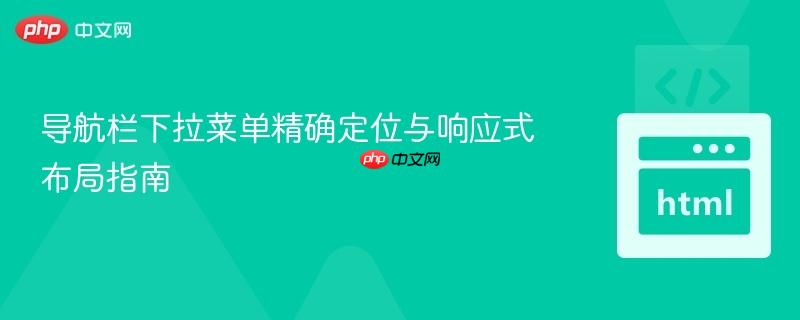
在网页开发中,实现一个功能完善且美观的导航栏下拉菜单是常见的需求。然而,确保下拉菜单能够精确地显示在其触发按钮下方,并且在不同屏幕尺寸下保持正确的定位,常常会遇到挑战。开发者可能会尝试使用 position: absolute 配合 left 属性进行定位,但这种方法在浏览器窗口调整大小时容易导致菜单错位。当尝试使用 position: relative 时,菜单又可能完全消失。
核心问题通常源于对CSS定位上下文(position属性)和内容溢出处理(overflow属性)的误解或不当使用。
当一个元素被设置为 position: absolute 并配合 left: 0 时,它会相对于其最近的已定位祖先元素(即 position 属性不为 static 的祖先元素)进行定位。如果没有这样的祖先元素,它将相对于 body 元素定位。在导航栏场景中,如果下拉菜单的父容器没有设置定位,那么 left: 0 会使其对齐到页面的最左侧,而不是其触发按钮的下方。即使父容器设置了 position: relative,left: 0 也只是将其对齐到父容器的左边缘,如果父容器的宽度是动态的,或者按钮本身不在父容器的最左侧,仍然会导致不对齐。
overflow: hidden 属性会裁剪掉元素内容超出其盒子模型的部分。这对于防止内容溢出容器非常有用,但在下拉菜单场景中,它却可能成为一个陷阱。如果下拉菜单的父容器(例如 .navbar 或 .dropdownL)设置了 overflow: hidden,那么当下拉菜单内容(position: absolute)尝试渲染到父容器外部时,就会被裁剪掉,导致菜单“消失”。这是导致 position: relative 看起来不起作用的常见原因,因为即使父元素提供了定位上下文,overflow: hidden 也会阻止子元素在其外部显示。
要实现一个稳定且响应式的下拉菜单,我们需要结合使用 position: relative、position: absolute,并注意 overflow 属性的设置。
以下是优化后的HTML和CSS代码,展示了如何正确实现导航栏下拉菜单的定位。
HTML结构 (index.html)
<!DOCTYPE html>
<html lang="zh-CN">
<head>
<meta charset="UTF-8">
<meta name="viewport" content="width=device-width, initial-scale=1.0">
<title>响应式导航栏下拉菜单</title>
<link rel="stylesheet" type="text/css" href="./index.css" />
<!-- 引入 Font Awesome 图标库,如果需要的话 -->
<link rel="stylesheet" href="https://cdnjs.cloudflare.com/ajax/libs/font-awesome/4.7.0/css/font-awesome.min.css">
</head>
<body>
<div class="navigationrow">
<div class="navbar">
<div><a href="#home">One</a></div>
<div><a href="#news">Two</a></div>
<div class="dropdownL">
<button class="dropbtnL">
Three
<i class="fa fa-caret-down"></i>
</button>
<div class="dropdown-contentL">
<div class="header">
<h2>Menu</h2>
</div>
<div class="row">
<div class="column">
<h3>Category 1</h3>
<a href="#">Link 1</a>
<a href="#">Link 2</a>
<a href="#">Link 3</a>
</div>
<div class="column">
<h3>Category 2</h3>
<a href="#">Link 1</a>
<a href="#">Link 2</a>
<a href="#">Link 3</a>
</div>
<div class="column">
<h3>Category 3</h3>
<a href="#">Link 1</a>
<a href="#">Link 2</a>
<a href="#">Link 3</a>
</div>
</div>
</div>
</div>
<!-- 可以添加更多导航项,保持 grid 布局的平衡 -->
<div><a href="#contact">Four</a></div>
</div>
</div>
</body>
</html>CSS样式 (index.css)
* {
box-sizing: border-box;
}
body {
margin: 0;
}
.navbar {
/* 移除 overflow: hidden,确保下拉菜单内容不会被裁剪 */
background-color: #333;
font-family: Arial, Helvetica, sans-serif;
display: grid; /* 保持原有的 grid 布局 */
grid-template-columns: repeat(4, 1fr); /* 调整为4列,每列等宽 */
grid-template-rows: 46px;
border: white 1px solid;
}
.navbar a {
/* float: left; 在 grid 布局下可能不再需要 */
font-size: 16px;
color: white;
text-align: center;
padding: 14px 16px;
text-decoration: none;
display: flex; /* 使用 flexbox 辅助内容居中 */
align-items: center;
justify-content: center;
}
.dropdownL {
/* float: left; 在 grid 布局下可能不再需要,但保留以兼容旧代码 */
/* 移除 overflow: hidden,确保下拉菜单内容不会被裁剪 */
position: relative; /* 为 dropdown-contentL 提供定位上下文 */
display: flex; /* 辅助按钮内容居中 */
align-items: center;
justify-content: center;
}
.dropdownL .dropbtnL {
font-size: 16px;
border: none;
outline: none;
color: white;
padding: 14px 16px;
background-color: inherit;
font: inherit;
margin: 0;
cursor: pointer; /* 增加鼠标手势 */
}
.navbar a:hover,
.dropdownL:hover .dropbtnL {
background-color: red;
}
.dropdown-contentL {
display: none;
position: absolute; /* 相对于 .dropdownL 定位 */
background-color: #F9F9F9;
width: 400px; /* 菜单固定宽度 */
left: 0; /* 使菜单左边缘与父元素 .dropdownL 左边缘对齐 */
box-shadow: 0px 8px 16px 0px rgba(0, 0, 0, 0.2);
z-index: 1;
/* 确保菜单在父元素下方显示,可以根据需要调整 top 值 */
top: 100%; /* 将菜单顶部与父元素底部对齐 */
}
.dropdown-contentL .header {
background: red;
padding: 16px;
color: white;
}
.dropdownL:hover .dropdown-contentL {
display: block;
}
/* 创建三列等宽布局 */
.row {
display: flex; /* 使用 flexbox 替代 float 实现列布局 */
}
.column {
flex: 1; /* 每列占据等宽空间 */
padding: 10px;
background-color: #CCC;
height: 250px;
border-right: 1px solid #AAA; /* 列之间添加分隔线 */
}
.column:last-child {
border-right: none; /* 最后一列没有右边框 */
}
.column a {
/* float: none; 在 flex 布局下不再需要 */
color: black;
padding: 16px;
text-decoration: none;
display: block;
text-align: left;
}
.column a:hover {
background-color: #DDD;
}
/* 响应式设计:小屏幕下的调整 */
@media screen and (max-width: 768px) {
.navbar {
grid-template-columns: repeat(2, 1fr); /* 小屏幕下导航栏两列布局 */
grid-auto-rows: auto; /* 自动调整行高 */
}
.dropdownL {
position: static; /* 在小屏幕下取消相对定位,使其回归文档流 */
grid-column: span 2; /* 下拉菜单占据两列,方便居中 */
justify-content: center; /* 按钮居中 */
}
.dropdown-contentL {
position: absolute; /* 保持绝对定位 */
width: 90%; /* 小屏幕下菜单宽度自适应 */
left: 5%; /* 左右各留 5% 边距 */
right: 5%;
margin-left: auto; /* 自动左右外边距实现水平居中 */
margin-right: auto;
top: 100%; /* 保持在按钮下方 */
max-width: 400px; /* 限制最大宽度 */
}
.row {
flex-direction: column; /* 小屏幕下内容列堆叠 */
}
.column {
width: 100%; /* 每列占据全部宽度 */
height: auto; /* 高度自适应 */
border-right: none;
border-bottom: 1px solid #AAA; /* 列之间添加底部边框 */
}
.column:last-child {
border-bottom: none;
}
}以上就是导航栏下拉菜单精确定位与响应式布局指南的详细内容,更多请关注php中文网其它相关文章!

每个人都需要一台速度更快、更稳定的 PC。随着时间的推移,垃圾文件、旧注册表数据和不必要的后台进程会占用资源并降低性能。幸运的是,许多工具可以让 Windows 保持平稳运行。

Copyright 2014-2025 https://www.php.cn/ All Rights Reserved | php.cn | 湘ICP备2023035733号